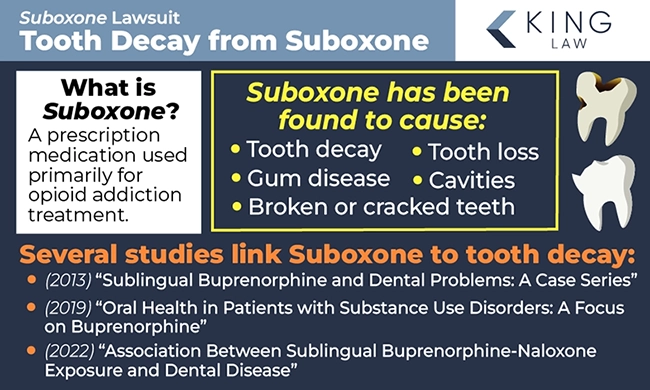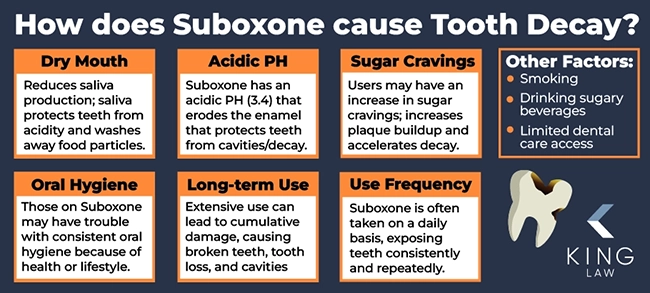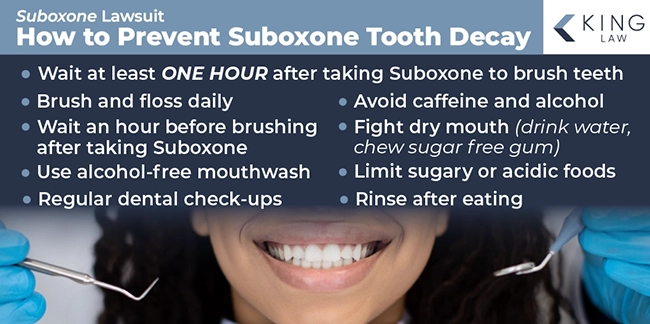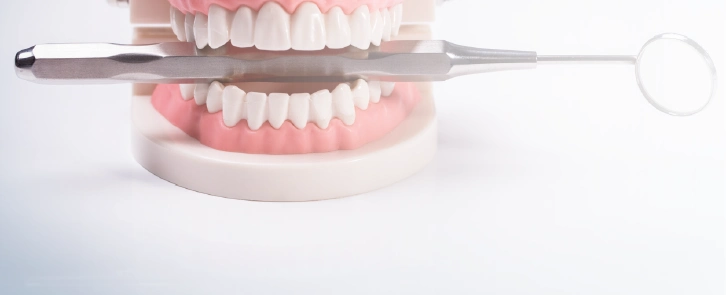
Legal claims allege that Suboxone, a drug widely used in addiction treatment programs nationwide, may cause severe dental issues, including tooth decay, cavities, and gum disease. According to multiple lawsuits, the manufacturer of Suboxone, Indivior, Inc., may have been aware of these risks, particularly with long-term use, and failed to adequately warn consumers. Despite their severity, dental issues were not listed as a potential side effect of the drug by Indivior until the U.S. Food and Drug Administration (FDA) updated the warning label in June 2022.
The prescription drug, a combination of buprenorphine and naloxone, is primarily used to treat opioid dependence by reducing withdrawal symptoms and cravings. Despite its effectiveness in treating opioid dependence, concerns continue to grow over the potential for these serious dental side effects, particularly with prolonged use. Recent studies have highlighted this risk and prompted further litigation and regulation. Individuals who suffered dental problems after taking Suboxone are encouraged to contact King Law to schedule a free case review to determine their legal options.
Recent Studies Linking Suboxone to Tooth Decay
September 16, 2024: FDA Warnings State Suboxone Sublingual Films Cause Tooth Decay
There has been no denying that Suboxone causes tooth decay since at least January 2022. In January 2022, the FDA stated that buprenorphine films caused tooth decay. Later in 2022, the warning label was changed on Suboxone and all generic Suboxone drugs to include warnings about dental problems. Since then, thousands of individuals have come forward with broken, cracked, or damaged teeth after using Suboxone or buprenorphine films.
April 2024: A clinical report published in the Journal of the American Dental Association (JADA) discussed the link between orally dissolving buprenorphine and caries.
October 2023: Professor Bing-Yan Wang of UTHealth Houston School of Dentistry is announced as the multiple principal investigator to study the impact of “oral exposure to buprenorphine on dental caries.”
August 2023: A research article published in Current Drug Safety analyzed dental disorders reported to the FDA Adverse Event Reporting System in association with Buprenorphine. The research corroborated previous findings that there was a correlation between buprenorphine-containing medications and adverse dental outcomes.
December 2022: A research letter filed in the Journal of the American Medical Association (JAMA) discusses the Association Between Sublingual Buprenorphine-Naloxone Exposure and Dental Disease. It found that people with sublingual buprenorphine/naloxone had a higher incidence of adverse dental events.
About the Suboxone Tooth Decay Lawsuit:
What Is Tooth Decay From Suboxone?
Can Suboxone Cause Tooth Decay?
How Does Suboxone Cause Tooth Decay?
Suboxone Sublingual Film: Oral Use and Instructions
Suboxone Tooth Side Effects and Oral Health Risks
How Common Is Tooth Decay Among Suboxone Users
Indivior, Inc. Adds Dental Adverse Events to Warning Label
How to Prevent Tooth Decay While Taking Suboxone
Have You Experienced Tooth Decay While Taking Suboxone?
What Is Tooth Decay From Suboxone?
Suboxone is a prescription medication containing buprenorphine and naloxone, used primarily for opioid addiction treatment. While it has been effective in managing opioid dependence, it has been linked to severe dental issues. In January 2022, the FDA issued a warning about potential dental problems with buprenorphine-containing medications dissolved in the mouth.
Lawsuits against Indivior, Inc., the manufacturer of Suboxone, allege that the medication can cause severe tooth decay, cavities, gum disease, broken teeth, and tooth loss, particularly with prolonged use. Suboxone users may require extensive dental work, such as tooth extraction, root canals, and crowns. Numerous lawsuits have been filed against Indivior, alleging that the company knew or should have known about the dental risks and failed to warn consumers.

Can Suboxone Cause Tooth Decay?
Research shows that there may be a direct link between Suboxone use and significant dental risks. The prescription drug is primarily used for opioid treatment and is available in sublingual films. It is believed that one of the main ingredients in Suboxone, buprenorphine, increases these risks.
Users of Suboxone report severe dental issues, including tooth decay, cavities, gum disease, and tooth loss. Even individuals with no prior dental issues can experience significant dental damage as a result of prolonged use of the medication. Litigation against the manufacturer of the drug argues consumers were not adequately warned about the potential dental side effects associated with Suboxone use.
Multiple Studies Link Suboxone to Tooth Decay
Over the past five years, Suboxone use has been consistently linked to significant dental problems, including tooth decay, gum disease, and enamel erosion. Research shows that patients on buprenorphine-based therapies, such as Suboxone, show a higher incidence of oral health issues compared to those not on the medication.
Key Studies:
- “Association Between Sublingual Buprenorphine-Naloxone Exposure and Dental Disease” (2022). The pharmacoepidemiologic study found a higher incidence of adverse dental events among users of sublingual buprenorphine-naloxone.
- “Buprenorphine-associated Oral Health Problems: A Review of Literature” (2021). Highlights the need for oral health monitoring due to adverse effects like dry mouth and dental caries.
- “The Impact of Buprenorphine on Oral Health: A Case Series” (2020). Presents case reports detailing severe dental issues directly linked to long-term Suboxone use.
- “Oral Health in Patients with Substance Use Disorders: A Focus on Buprenorphine” (2019). Finds higher rates of dental problems in patients on buprenorphine therapy compared to those not on the medication.
- “Dental Problems and Oral Health in Patients Receiving Buprenorphine Maintenance Treatment” (2017). Indicates increased tooth decay and gum disease prevalence in patients undergoing buprenorphine maintenance treatment.
- “Sublingual Buprenorphine and Dental Problems: A Case Series” (2013). Found a potential association between buprenorphine and dental problems.
These studies provide strong evidence connecting Suboxone use to elevated risks of dental problems. They emphasize the importance of routine check-ups and dental health monitoring for patients taking Suboxone who may be at a higher risk for caries and other issues.
How Does Suboxone Cause Tooth Decay?
The link between Suboxone and tooth decay may be the result of several factors including its tendency to cause dry mouth, high acidic pH, and ability to cause increased cravings for sugary foods. It may also be the result of frequent dosing, challenges in oral hygiene, or other lifestyle factors. Suboxone users are encouraged to engage in regular dental monitoring and check-ups to ensure oral health and prompt diagnosis of any problems.
Mechanisms Contributing to Tooth Decay:
- Dry Mouth (Xerostomia): Suboxone reduces saliva production, creating a more acidic environment and allowing food particles to remain on teeth longer. This results in an increased risk of tooth decay due to a lack of the saliva’s protective functions (neutralizing acids, washing away food particles).
- Acidic pH of Suboxone: Suboxone has an acidic pH (around 3.4) that can erode tooth enamel. Enamel erosion makes teeth more susceptible to cavities and decay.
- Increased Sugar Cravings: Suboxone users may experience increased cravings for sugary foods and beverages. Frequent sugar consumption leads to more plaque buildup, accelerating decay, especially in an already acidic environment.
- Frequency of Dosing: Suboxone is often taken daily, repeatedly exposing teeth to decay-causing factors like acidity and dry mouth. Consistent exposure to the drug increases the likelihood of long-term dental problems.
- Challenges in Oral Hygiene: Individuals using Suboxone may face difficulties maintaining regular oral hygiene due to lifestyle factors or health issues. Poor oral hygiene exacerbates the risk of tooth decay and other dental problems.
- Long-Term Use: Prolonged use of Suboxone leads to cumulative damage, including continuous enamel erosion and dry mouth effects. This may lead to significant dental issues over time, such as cavities, broken teeth, and tooth loss.
- Additional Contributing Factors: Smoking, drinking sugary beverages, and limited access to dental care can further exacerbate dental problems in Suboxone users.
The mechanisms of dry mouth, acidic pH, frequent dosing, and lifestyle challenges make Suboxone use a significant risk factor for severe dental health issues. Individuals diagnosed with dental caries or other problems after taking the prescription are encouraged to seek legal counsel.

Suboxone Sublingual Film: Oral Use and Instructions
Suboxone sublingual film is placed under the tongue or inside the cheek for absorption into the bloodstream. This method bypasses the digestive system but directly affects the oral cavity. Users of the drug are informed to wash their hands thoroughly before handling the film and rinse their mouth with water to remove food or drink residues that might affect absorption.
Proper use of Suboxone requires:
- Careful Handling: Users are told to avoid touching the sticky side of the film as much as possible.
- Correct Placement: Correct placement involves putting the film under the tongue or on opposite sides if using multiple films, ensuring they do not overlap.
- Proper Dissolution: Users must allow the film to dissolve completely under the tongue without chewing, swallowing, or moving it.
- Avoiding Eating or Drinking: It is important to refrain from eating or drinking until the film is fully dissolved to ensure proper absorption.
Suboxone users are encouraged to follow their healthcare provider’s instructions, particularly when placing each film in different areas under the tongue, to avoid overlap. After the film has dissolved completely, individuals may swallow saliva normally.
Suboxone Tooth Side Effects and Oral Health Risks
There are a number of serious tooth side effects and oral health risks associated with Suboxone use, including tooth decay, enamel erosion, gum disease, oral infections, tooth sensitivity, broken teeth, and oral irritation. In 2022, the FDA issued a warning to consumers about the risk of these harms with medicines containing buprenorphine that are dissolved in the mouth. Individuals taking the medication are advised to engage in routine dental checkups and consult with an attorney if any adverse reactions are encountered.
Oral health risks associated with Suboxone:
- Tooth Decay (Cavities): Acidic pH and dry mouth (xerostomia) reduce saliva production, leading to a more acidic environment and increased risk of cavities. Prolonged exposure weakens enamel, causing severe tooth decay if not treated.
- Enamel Erosion: Suboxone’s acidic nature erodes the protective enamel layer over time, resulting in tooth sensitivity, increased likelihood of cavities, and potential fractures.
- Gum Disease (Gingivitis and Periodontitis): Dry mouth, poor oral hygiene, and plaque buildup can lead to gum inflammation and progression to more severe gum disease. Gum disease may cause bleeding gums, bad breath, gum recession, and tooth loss.
- Oral Infections: Dry mouth reduces natural defense mechanisms, leading to bacterial and fungal growth, which can result in infections like thrush. These can cause pain, difficulty eating, and further complications.
- Tooth Sensitivity: Enamel erosion and gum recession exposed dentin, leading to increased sensitivity. Tooth sensitivity can lead to discomfort when consuming hot, cold, or sweet foods and drinks, impacting your quality of life.
- Broken or Fractured Teeth: Weakened enamel from erosion and decay increases the risk of teeth breaking or fracturing. Broken teeth may cause pain and difficulty chewing, and restorative dental treatments may be required.
- Oral Irritation and Ulcers: Sublingual Suboxone can cause irritation or ulcers under the tongue or gums due to prolonged contact with oral tissues. Persistent irritation can lead to discomfort, difficulty in eating and speaking, and secondary infections.
Common Tooth Side Effects of Suboxone:
- Tooth decay: Rapid progression, often referred to as “rampant caries.”
- Cavities: Quick development leading to more severe dental problems.
- Oral infections: These can include dental abscesses.
- Tooth erosion: Caused by Suboxone’s acidic nature.
- Tooth loss: In severe cases, tooth loss may occur.
The FDA has issued a warning about serious dental problems associated with Suboxone and other buprenorphine-containing medications. These problems can occur even in individuals with no prior dental issues. Unfortunately, the risk of severe dental issues was not prominently listed on the drug’s label until after the FDA issued the warning.
How Common Is Tooth Decay Among Suboxone Users?
Tooth decay is surprisingly common among Suboxone users. Clinical observations and other studies highlight an increased risk among individuals taking medications containing buprenorphine, making regular dental care and proactive oral hygiene critical to mitigating these risks.
Limited large-scale studies exist, but smaller studies and surveys indicate a higher incidence of dental issues, including cavities, enamel erosion, and gum disease among Suboxone users. One study found that over 50% of patients using buprenorphine-based medications like Suboxone reported moderate to severe dental problems. The FDA reported 305 cases of dental issues linked to buprenorphine, with 131 cases being severe, though not all Suboxone users experience dental issues.
Factors contributing to the prevalence of tooth decay among Suboxone users:
- Dry Mouth (Xerostomia): Suboxone significantly reduces saliva production, a major protective factor against tooth decay, leading to higher prevalence among users.
- Duration of Use: Longer use of Suboxone increases the likelihood of dental problems due to prolonged exposure to decay risk factors.
- Oral Hygiene Practices: Poor oral hygiene significantly increases the risk of tooth decay, though even users with good hygiene may still experience dental issues.
Many users report rapid tooth decay and significant dental issues after starting Suboxone, often requiring extensive dental work like fillings, crowns, or extractions. Tooth decay is widely recognized as a common side effect of Suboxone use, with an increased incidence compared to non-users. Dental health issues may be noticed soon after beginning treatment, but sometimes, they remain unnoticed until the next dental checkup. The longer the problems go undiagnosed and untreated, the more likely they are to become severe.
Indivior, Inc. Adds Dental Adverse Events to Warning Label
After multiple reports of adverse dental events potentially linked to Suboxone, the FDA required a new warning to be added to the prescribing information and patient Medication Guide for all buprenorphine-containing medicines that dissolve in the mouth. The updated label acknowledges the potential for severe dental problems, including tooth decay, gum disease, and enamel erosion associated with Suboxone use. It now includes specific dental issues such as cavities, tooth loss, gum disease, enamel erosion, oral infections, and dry mouth (xerostomia). The label emphasizes staying hydrated and using saliva substitutes or sugar-free gum to help mitigate dry mouth.
The FDA monitored reports linking Suboxone to dental problems through its MedWatch program, leading to increased scrutiny of the drug’s safety. In January 2022, the FDA issued public warnings about the increased risk of dental problems associated with Suboxone, emphasizing the need for regular dental care. The FDA mandated that Indivior update Suboxone’s label to include dental risk information, ensuring patients and providers are fully informed. The FDA continues to monitor the situation and may take further action if necessary to protect public health.
Patients are advised to maintain diligent oral hygiene, schedule regular dental check-ups, and promptly report any dental symptoms to their healthcare provider. Providers are encouraged to discuss potential dental risks with patients before prescribing Suboxone, monitor for dental issues during follow-ups, and refer to a dentist if necessary. The inclusion of dental warnings reflects growing concerns and could have legal implications for ongoing and future litigation related to Suboxone’s side effects.
How to Prevent Tooth Decay While Taking Suboxone
While tooth decay can occur in people taking Suboxone with no prior dental issues, steps can be taken to prevent these problems. These include maintaining good oral hygiene with daily brushing, flossing, and using fluoride mouth rinse. Suboxone patients are encouraged to combat dry mouth through hydration and saliva substitutes, monitor diet by limiting sugary and acidic foods, engage in regular dental check-ups, use fluoride treatments, properly manage medication, and make lifestyle adjustments.
Steps to take to prevent tooth decay while taking Suboxone:
- Brush and Floss Daily: Use fluoride toothpaste to strengthen enamel and floss to remove food particles and plaque, reducing the risk of cavities and gum disease.
- Use a Mouth Rinse: Consider an alcohol-free, fluoride mouth rinse, especially those designed to combat dry mouth.
- Combat Dry Mouth: Drink plenty of water, chew sugar-free gum to stimulate saliva production, and consider using over-the-counter saliva substitutes to maintain moisture.
- Avoid Caffeine and Alcohol: Limit these as they can worsen dry mouth.
- Monitor Your Diet: Limit sugary and acidic foods as these contribute to plaque buildup and enamel erosion, especially in a dry mouth environment.
- Rinse After Eating: Rinse with water after consuming sugary or acidic foods to neutralize acids.
- Engage in Regular Dental Check-Ups: Schedule check-ups and cleanings every six months, or more frequently if recommended, and inform your dentist about Suboxone use for tailored care.
- Use Fluoride Treatments: Ask your dentist about treatments or supplements for extra protection against decay.
- Medication Management: After taking Suboxone, wait at least an hour before brushing and rinse with water to remove any residue and neutralize acidity.

Have You Experienced Tooth Decay While Taking Suboxone?
Individuals who have experienced tooth decay while taking Suboxone are encouraged to seek legal counsel. Depending on the circumstances of the case, aggrieved parties may be eligible for compensation. At King Law, our lawyers are well-versed in handling Suboxone lawsuits and can assist you in determining the value and validity of your claim.
Our lawyers will work with you to:
- Determine eligibility for filing a lawsuit.
- Help collect evidence that can substantiate your claim.
- File the lawsuit in the appropriate courthouse.
- Ensure the claim meets all legal requirements, including filing within the statute of limitations.
- Negotiate for a favorable settlement in the case.
- Take the matter to trial if a fair and full settlement cannot be reached.
Contact a Suboxone Tooth Decay Lawyer
Contact a Suboxone tooth decay lawyer at King Law today. We have extensive experience handling these cases and will fight hard to ensure you receive the recovery you deserve. Contact our office now to get started with a free initial consultation.

